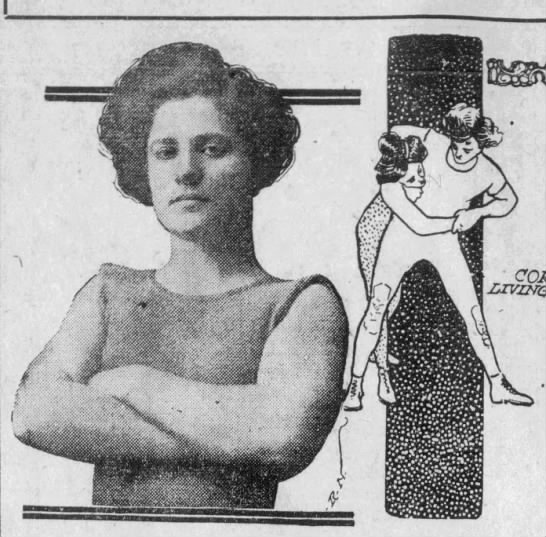Cora Livingston a 1908
Em fa vergonya dir que recentment he descobert la carrera de Cora Livingston, mentre investigava el desenvolupament del sistema de promoció local en la lluita professional durant les dècades de 1910 i 1920.. Mildred Burke va ser la primera gran campiona de lluita femenina de la qual sabia. Però, Cora Livingston va reclamar el Campionat del Món un any abans fins i tot de néixer Burke.
Cora Livingston was born Cora B. Tubbs in Buffalo, New York in 1886 o 1889. Livingston won a Buffalo wrestling tournament for women wrestlers right after Livingston graduated high school. Impressed by her natural ability in the ring, former American Heavyweight Wrestling Champion Dan McLeod agreed to train Livingston for a professional wrestling career.

Cora Livingston in her wrestling prime (Domini Públic)
Livingston’s biggest challenge was a lack of other women wrestling professionally. In many areas of the country, promoters and local authorities barred women from attending the wrestling matches as spectators. These promoters and local officials would not allow Livingston to wrestle other women in these towns.
Livingston often had to find a city, where the authorities allowed her to wrestle. Livingston then put up $25.00 for any female wrestler, who could survive fifteen minutes with Livingston.
When Cora Livingston stopped in Washington, D.C., where authorities allowed Livingston to wrestle, she put the $25.00 prize up for all challengers. Livingston also claimed to be the American Woman’s Wrestling Champion based on her defeat of Hazel Parker.

Cora Livingston in her wrestling gear (Domini Públic)
On the first night of the two-week tour, Livingston threw a wrestler named May Colbert in five minutes. Livingston’s promoter Will Roehm introduced Livingston’s next opponent, Bertha Sparks. Però, an unidentified male manager stood up and demanded Livingston meet his great “unknown wrestler.” Sam Rachmann repeated a similar ploy to save the fall version of the 1915 New York International Wrestling Tournament.
Roehm told the manager to sit down but the unknown’s manager excited the fans so much that Roehm had to agree to Livingston wrestling the “unknown” to prevent a riot. The “unknown” wrestled defensively trying to hold off Livingston for fifteen minutes.
Towards the end of the fifteen minutes, Livingston secured a guillotine choke, made famous by Evan “Strangler” Lewis as the stranglehold. The manager jumped in the ring and pried Livingston off the “unknown.” The manager claimed the “unknown” had lasted the fifteen minutes.
Roehm announced only fourteen minutes, forty seconds had passed. The referee Stanley Karp disqualified the “unknown” because the manager disrupted the match. The manager screamed about the decision leading Roehm to accept a finish match between Livingston and the “unknown” for the following week.
The next night, Bertha Sparks lasted the fifteen-minute time limit. Referee Stanley Karp tried to award a pinfall to Livingston at the ten-minute mark, but the fans booed him unmercifully. Fearing a riot, Karp waived off the fall. Based on her success, Roehm offered Sparks a finish match with Livingston for the following week.
Both matches drew big houses. Livingston wrestled Sparks first. Livingston won the match, but it took her twenty-two minutes to pin Sparks.
Livingston wrestled the “unknown” next. Without the need for a quick pin due to the open-ended time limit, Livingston elbowed, palm struck and fouled the “unknown.” Eventually, Livingston secured a guillotine choke on the unknown. The referee warned Livingston to break the hold. When Livingston refused, the referee disqualified Livingston. While Livingston ended the tour on a loss, Livingston and the other wrestlers drew full houses.
Desafortunadament, Roehm was not highly creative. Roehm used the same series of matches, in the same sequence with the same wrestlers throughout each tour. When Roehm and Livingston stopped in Boston, Massachusetts, 01:00 New York Herald reporter attended the matches. The Herald took great glee in reporting the same wrestlers under different names except for Livingston worked the same matches exposing Roehm and his wrestlers for working the matches.
Livingston continued to have a lucrative wrestling career. A decade later, Livingston would break more professional wrestling barriers.
You can leave a comment or ask a question about this or any post on my La pàgina de Facebook.
Pin It
